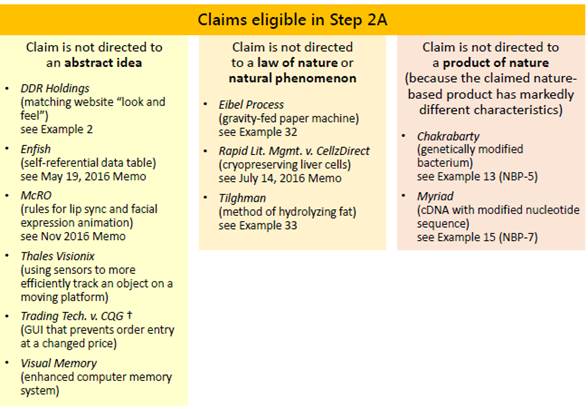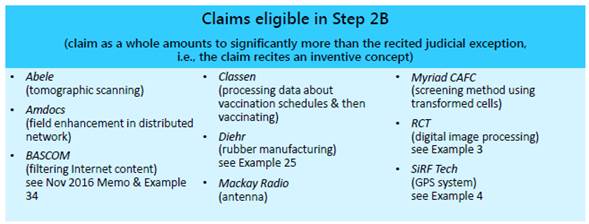
|
What’s Going on with Eligibility Examination under 101? 101条審査に対して 特許庁の状況は?司法では何か動きは? Summarized
by Tatsuo YABE – 2018-01-31 |
|
101条の現状(2018年1月時点):
2018年1月時点で特許保護適格性(101条審査)に対して米国特許庁はどのような対応をしているのか、且つ、司法で何か動きはあるのか?
|
一言で云うと米国特許庁は明瞭な審査基準を出していない。然しながら、ソフトウェア関連発明或いは制御技術関連の発明の出願審査において101条拒絶を受ける頻度は増えている。明瞭な審査ガイダンスがないので、101条拒絶を克服するのに事案ごとに対応の仕方はまちまちである。唯一、共通しているのはAlice第1ステップに対しては構造物に相当するエレメントをクレーム補正で追加すること、第2ステップに対しては「発明概念(“inventive
concept”)」が存在するということを主張できるようにクレームを補正することである。尚、「発明概念」がクレームの構成要素にあることを審査官に説得するには101条の条文にある「useful」という言葉が重要と考える。即ち、クレームされた発明は技術課題を解決する技術的解決手段であることを挙証する。言い換えると、クレームで列記された構成要素によって技術課題が解決されるという技術的な効果を現実の世にもたらすことを主張する(或いは、それを主張できるように然るべく特徴をクレームに追加或いはクレームを補正する)。
|
特許庁がだめなら裁判所の力を借りたいのだが、101条関連のCAFC判決の整合性を読み取るのは困難である。然し、今年になってから異様と思えるほど広範なクレームの特許保護適格性が認められたCAFC判決がでた。FINJAN
v. Blue Coat System
とCore Wireless v. LG Electronics
共に2018年1月のCAFC判決で、特にCoreの判決文の7-9ページは101条拒絶に反論するときの参考になると思料する(Referenceに原文)。
|
さらに、現在4件の最高裁へ裁量上告がある。4件の裁量上告でAlice/Mayo判決の第2ステップをパスするための「発明概念」とは何かを真っ向から争点にしているものはない。唯一、Recognicorp
v. Nintendoにおいて若干関連するであろう2つの争点があり、第1は、暗号化或いは解読に対する既存の技術プロセスに特定の改良を加えるコンピューター作動型の発明は仮にそれが抽象概念に関連或いは活用しているとしてもAlice判決の第1ステップで保護適格性を満たす(i.e.,
claim is not directed to an abstract idea)のではないか? 第2は、新規の数学のアルゴリズムを活用しバンド幅とメモリー使用を減らすことによって既存の技術ステップに改良を齎すことはAlice判決の第2ステップの”inventive
concept(発明概念)”を構成しないのか?を争点としている。Recognicorp事件が受理される可能性は高いとは言えないが、他の3件も含めて何れかが受理された場合に傍論であっても101条拒絶に対抗するのに有効なキーワードが出ることを期待しよう。(以上筆者)
|
*****************************************
|
■ PTOの対応
2010年以降に出た4件の最高裁判決(Bilski;
Mayo;
Myriad;
Alice)によって特許保護適格性の判断基準が不明瞭となったことは否めない。特許庁も一生懸命になって何とか解りやすい審査ガイダンスを出そうと試みたが、結局労多くして実り無しでギブアップしてしまった。その証拠に2016年10月に官報で最高裁判決に対するパブリックコメントを求めるとともにRoundtableディスカッション(2016-11
& 2016-12)を実施し、関係者(団体及び個人)に意見及び改善提案を求めた。2017年7月にRoundtableディスカッション及び関係者によるパブコメを集約し、報告書を作成し公開した(Reference表1を参照)。
|
50枚を超える報告書ではあるが、内容は特許保護適格性の歴史(立法及び司法)、IP5での対応に加えて、Roundtableディスカッションでの意見及び関係者からの意見及び提案事項のまとめに終わった。これら集積した意見を基にUSPTOの101条審査を今後どのように充実させていくかということに関しては触れていない。
|
しかし、PTOが抽出した公共(Public
Comment)からの推奨事項の中で頻出するキーワードは技術課題に対する技術解決手段(technical
solution to a technical problem:日本及び欧州での対応と類似)と有益性(useful)である。即ち、これら用語が101条の特許保護適格性に対する判断基準として最高裁判決後(2014年のAlice以降)のCAFC判決において良く用いられているということと、そもそも101条の条文においてusefulという用語が使用されていることである。上記報告書を読む限りにおいてUSPTOが101条判断基準に対し過去に出した審査ガイダンスの内容を大きく変更するとは考え難い。然るに出願実務者としては101条拒絶に対してはクレームされた発明はa
technical problemに対しa technical solutionを提供する、或いは、a
tangible and useful resultを現出する構成要素がクレームされているという結論に結び付けられるように反論するのが妥当と思料する。
|
2018年1月4日、明瞭なガイダンスを出せない特許庁は成すすべもなくAlice判決後(2014年後)の101条関連のCAFC判決(遺伝子変換されたバクテリアに適格性を認めた1980年のChakrabarty最高裁判決及びcDNAの適格性を認めたMyriad最高裁も含む)においてステップ2A(Alice/Mayo
Part 1)で適格性が認められた判例とステップ2B(Alice/Mayo
Part 2)で適格性が認められたCAFC判例を1ページの表にまとめている。所謂、CAFCの101条関連判決早見表といったところだが、特許庁のコメント無しには、この表を参酌するだけでは審査ガイダンスとはなりえない(Reference表2を参照)。
|
上記のように現時点では特許庁は足踏み状態で、この状況をどう打開していくのか、或いは、どのように統一性のある101条審査をしていくのか静観するしかない。
|
■ 司法では?
|
今年(2018年)になってから異様と思えるほど広範なクレームの特許保護適格性が認められたCAFC判決が2件でた。
FINJAN
v. Blue Coat System
Fed.
Cir. 2018-01-10
Core
Wireless v. LG Electronics
- Fed. Cir. 2018-01-25
FINJAN判決と
CORE判決に共通するのは従来技術に対するImprovement(改善)に基づきクレームはAbstractアイデアではない(Aliceステップ1をクリア)とCAFCは判断している。特に、Core判決では、Enfish判決、Thales判決、Visual
Memory判決、Fijnjan判決において改善されたシステムがクレームされているのと同様にCoreの476特許クレームは従来のシステムを改善する特定のシステムを規定していると述べている。本判決文(Core
Wireless Licensing v. LG Elects. Inc.: Fed. Cir. 2017-01-25)の7〜9ページの内容は101条拒絶に反論するのに有益である[Referenceに原文あり]。⇒ 従来システムを改善する特定のシステムというキーワードを言い換えると、結局は以下のフレーズに集約されるのではないか(筆者)。
「クレームされた発明はa
technical problem(従来技術の問題)に対しa
technical solution(技術的な解決手段)を提供する、或いは、a
tangible and useful resultを現出する構成要素がクレームされている」
|
さらに、Reference表3に示すように4件の事件(CAFC判決)が裁量上告されている。
[1]
Prism Tech v. T-Mobile USA -
Petitioned:
2017-08-24
争点:
101条適格性判断の基礎となった地裁の事実認定を本事件ではCAFCはde
novo(地裁の事実認定を無視)でレビュしたが、本来はclear
error基準(地裁の事実認定が明らかに間違っている場合のみ否定する)でレビュするべきではないのか?
|
[2]
Recognicorp v. Nintendo -
Petitioned:
2017-11-1
争点:
1.暗号化或いは解読に対する既存の技術プロセスに特定の改良を加えるコンピューター作動型の発明は仮にそれが抽象概念に関連或いは活用しているとしてもAlice判決の第1ステップで保護適格性を満たすのではないか?
2.新規の数学のアルゴリズムを活用しバンド幅とメモリー使用を減らすことによって既存の技術ステップに改良を齎すことはAlice判決の第2ステップの”inventive
concept(発明概念)”を構成しないのか?
|
[3]
RPost Comm. v. GoDaddy, LLC -
Petitioned:
2017-11-6
争点:
282条(b)項で規定された特許無効理由には101条の適格性は規定されていないに拘らず訴訟で101条を無効理由に使うのは正しいのか?
|
[4]
R+L
Carries v. Intermec Technologies
– Petitioned: 2018-01-09
争点:
1.
クレームの個々のステップを考慮することなく2014年のAlice最高裁判決の第1ステップによる「特許クレームが抽象概念を対象とする」と判断して良いのか?
2.
クレームが抽象概念を対象とするものか否かに対する重大な事実の争点があることを確証する証拠が記録されている(相手側も証拠の存在に対して反論していない)場合において、「発明は保護不適格である」とする略式判決を裁判所が下すことは連邦民事訴訟規則56条c項、1986年のAnderson最高裁判決、及び、1986年のCelotex最高裁判決によって禁止されているのではないか?
|
*********************************************
References:
|
■ 表1:
以下の表はPTOの101条審査関連のアクションをリストアップしたもので、PTOのガイダンス及びメモランダムに関連するCAFCの101条関連判決のみ記載
|
Supreme Court
Decisions |
Fed
Cir Decisions |
PTO |
|
Bilski (2010) |
|
|
|
Mayo (2012) |
|
|
|
Myriad (2013) |
|
|
|
|
Alice
v. CLS (en banc) |
Exam
Guidance (2014/3) |
|
Alice v. CLS
(2014) |
|
Interim
Exam Guidance (2014/12) |
|
|
|
Guidance
Updated (2015/7) |
|
|
|
2016/5/4:
Memorandum |
|
|
Enfish
2016/5/12 TLI
2016/5/17 |
2016/5/19:
Memorandum |
|
|
Bascom
2016/6/27 Sequenom
2016/6/27 |
|
|
|
Rapid
Litigation 2016/7/5 |
2016/7/14:
Memorandum |
|
|
Electric
Power 2016/8/1 |
|
|
|
|
2016/10/17:
Requested Public Comments; 2016-11-14 & 2016-12/5: Holding Roundtable
discussions. |
|
|
|
2017-7:
Published Report summarizing public comments and the roundtable
discussions. |
|
|
|
2018-01-04:
Published “Eligibility Quick Reference Table” |
|
■ 表2:
PTO 2018-01-04
January 2018: Eligibility Quick Reference Sheet
Decisions Holding Claims Eligible

|

|
■ 表3:
2018年1月時点で、4件のCAFC判決が裁量上告されている。
|
|
Petition for Review by
Supreme Court
(Pending) |
Issues |
|
Prism Tech
v. T-Mobile USA Petitioned: 2017-08-24 |
Whether a
district court’s factual findings in support of its holding that claims
are directed to patent eligible subject matter may be reviewed de
novo, as the Federal Circuit requires (and as the panel did in this
case), or only for clear error, as Rule 52(a) and corollary Supreme Court
precedent require. 101条適格性判断の基礎となった地裁の事実認定を本事件ではCAFCはde
novo(地裁の事実認定を無視)でレビュしたが、本来はclear error基準(地裁の事実認定が明らかに間違っている場合のみ否定する)でレビュするべきではないのか? |
|
Recognicorp v.
Nintendo Petitioned: 2017-11-1 |
1. Whether
computer-implemented inventions that provide specific improvements to
existing technological processes for encoding or decoding data are
patent-eligible under the first step of the Alice test, even if those
inventions involve or make use of abstract ideas. 暗号化或いは解読に対する既存の技術プロセスに特定の改良を加えるコンピューター作動型の発明は仮にそれが抽象概念に関連或いは活用しているとしてもAlice判決の第1ステップで適格性を満たすのではないか? 2. Whether the
use of new mathematical algorithms to improve existing technological
processes by reducing bandwidth and memory usage can constitute
“inventive concepts” under the second step of the Alice test. 新規の数学のアルゴリズムを活用しバンド幅とメモリー使用を減らすことによって既存の技術ステップに改良を齎すことはAlice判決の第2ステップの”inventive concept(発明概念)”を構成しないのか? |
|
RPost Comm. v. GoDaddy,
LLC Petitioned: 2017-11-6 |
Is patent
ineligibility under 35 U.S.C. § 101, which Congress did not codify in
35 U.S.C. § 282(b), not a cognizable defense in a patent litigation? The
same type of statutory analysis [applied in SCA: laches] must be applied
here because no word or phrase in § 282(b) codifies ineligibility as a
litigation defense. 282条(b)項で規定された特許無効理由には101条の適格性は規定されていないに拘らず訴訟で101条を無効理由に使うのは正しいのか? |
|
R+L Carries v.
Intermec Technologies Petitioned: 2018-01-09 |
1. May a court
determine that a patent claim is “directed to” an abstract idea under
Step 1 of Alice Corp (2014) without analyzing the requirements of the
individual claim steps? クレームの個々のステップを考慮することなく2014年のAlice最高裁判決の第1ステップによる「特許クレームが抽象概念を対象とする」と判断して良いのか? 2. Do Fed. R.
Civ. P. 56(c), Anderson v. Liberty Lobby (1986) and Celotex Corp
v. Catrett (1986) prohibit a court from entering a summary judgment
finding that an invention is ineligible for patent protection when the
record contains uncontroverted, relevant evidence establishing that there
is at least a genuine issue of material fact as to whether the claim is
“directed to” an abstract idea? クレームが抽象概念を対象とするものか否かに対する重大な事実の争点があることを確証する証拠が記録されている場合において、「発明は保護不適格である」とする略式判決を裁判所が下すことは連邦民事訴訟規則56条c項、1986年のAnderson最高裁判決、及び、1986年のCelotex最高裁判決によって禁止されているのではないか? |
|
■ Core Wireless
Licensing v. LG Elects. Inc.: Fed. Cir.
2017-01-25)判決7〜9ページ原文(赤色、下線等は筆者挿入)
At
step one, we must “articulate what the claims are directed to with enough
specificity to ensure the step one inquiry is meaningful.” Thales Visionix
Inc. v. United States, 850 F.3d 1343, 1347 (Fed. Cir. 2017). Although there
is “difficulty inherent in delineating the contours of an abstract idea,” Visual
Memory, 867 F.3d at 1259, we must be mindful that “all inventions at some
level embody, use, reflect, rest upon, or apply laws of nature, natural
phenomena, or abstract ideas.” Mayo, 566 U.S. at 71. We also ask
whether the claims are directed to a specific improvement in the capabilities of
computing devices, or, instead, “a process that qualifies as an ‘abstract
idea’ for which computers are invoked merely as a tool.” Enfish, LLC v.
Microsoft Corp., 822 F.3d 1327, 1336 (Fed. Cir. 2016).
We previously have held claims focused on various improvements of systems
directed to patent eligible subject matter under § 101. For example, in Enfish,
we held claims reciting a self-referential table for a computer database
eligible under step one because the claims were directed to a particular
improvement in the computer’s functionality. 822 F.3d at 1336. That the
invention ran on a general-purpose computer did not doom the claims because
unlike claims that merely “add[] conventional computer components to
well-known business practices,” the claimed self-referential table was “a
specific type of data structure designed to improve the way a computer stores
and retrieves data in memory.” Id. at 1338–39. In Thales,
we held claims reciting an improved method of utilizing inertial sensors to
determine position and orientation of an object on a moving platform not
directed to an abstract idea or law of nature. 850 F.3d at 1349. We noted
that even though the system used conventional sensors and a mathematical
equation, the claims specified a particular configuration of the sensors and
a particular method of utilizing the raw data that eliminated many of the
complications inherent in conventional methods. Id. at 1348–49.
In Visual Memory, we held claims
directed to an improved computer memory system with programmable operational
characteristics defined by the processor directed to patent-eligible subject
matter. 867 F.3d at 1259. The claimed invention provided flexibility that prior
art processors did not possess, and obviated the need to design a separate
memory system for each type of processor. Id
And most recently, in Finjan,
Inc. v. Blue Coat Systems, Inc., we held claims directed to a
behavior-based virus scanning method directed to patent eligible subject matter
because they “employ[] a new kind of file that enables a computer security
system to do things it could not do before,” including “accumulat[ing]
and utiliz[ing] newly available, behavior-based information about potential
threats.” 2018 WL 341882 (Fed. Cir. Jan. 10, 2018). The claimed behavior-based
scans, in contrast to prior art systems which searched for matching code,
enabled more “nuanced virus filtering” in analyzing whether “a
downloadable’s code . . . performs potentially dangerous or unwanted
operations.” Id. at 6–7. We held the claims “therefore directed
to a non-abstract improvement in functionality, rather than the abstract idea of
computer security writ large.” Id. at 8.
The asserted claims in this case are directed to an improved user
interface for computing devices, not to the abstract idea of an index, as
argued by LG on appeal. Although the generic idea of summarizing information
certainly existed prior to the invention, these claims are directed to a
particular manner of summarizing and presenting information in electronic
devices. Claim 1 of the ’476 patent requires “an application summary that
can be reached directly from the menu,” specifying a particular manner by
which the summary window must be accessed. The claim further requires the
application summary window list a limited set of data, “each of the data in
the list being selectable to launch the respective application and enable the
selected data to be seen within the respective application.” This claim
limitation re-strains the type of data that can be displayed in the summary
window. Finally, the claim recites that the summary window “is displayed while
the one or more applications are in an un-launched state,” a requirement that
the device applications exist in a particular state. These limitations
disclose a specific manner of displaying a limited set of information to the
user, rather than using conventional user interface methods to display a generic
index on a computer. Like the improved systems claimed in Enfish,
Thales, Visual Memory, and Finjan,
these claims recite a specific improvement over prior systems, resulting in
an improved user interface for electronic devices.
|
|
(5)
LINKS
|